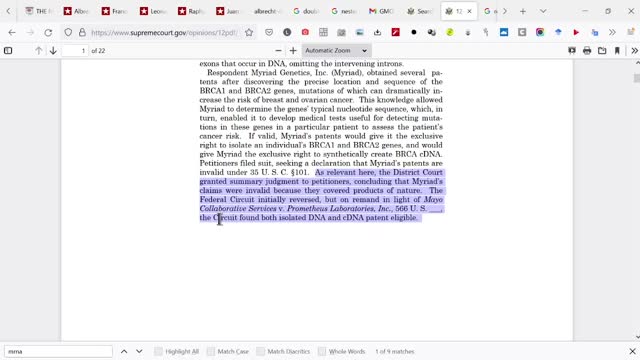Premium Only Content

You Are being "Patented" aka "Owned" ...mRNA...
you're being "Patented" aka "Owned" mRNA
https://www.supremecourt.gov/search.aspx?Search=12-398&type=Site
https://www.supremecourt.gov/opinions/12pdf/12-398_1b7d.pdf
Supreme Court:
Pfi*zer, Mod*erna et al.
may own your genes
once you’re injected with their
lab-created m R N A, D N A
**\The Supreme Court ruled that if there is anything synthetic,
not from nature, inside of our genome,
then whoever owns the patent on those synthetic
parts now owns part or all of you as a human.
That means Bi*ll and Meli*nda Gates et al.,
*****The Department of Defense, et al.
can literally own a human being.
If this synthetic code is taken up into your genome,
by law,
you could be owned overnight.”
All legitimate doctors and scientists welcome fact-checking and peer-review.
***Turns out Dr. Madej is onto something, and further affirms every reason not to volunteer for these experimental injections.
*****Man-made bacteria and genetically-modified mice are patentable
The case of Diamond v. Chakrabarty,
*** 447 U.S. 303 (1980) is the first time the U.S. Supreme Court heard a patent case involving naturally-occurring processes and/or organisms.
Dr. Ananda Mohan Chakrabarty invented a species of oil-eating bacteria while working at General Electric in 1971.
His invention streamlined the process of cleaning up oil spills.
He filed a first-of-its-kind patent for the new genetically-modified bacteria species.
The United Kingdom granted the patent already.
But the U.S. Patent and Trademark Office denied the patent because it determined the invention was a living organism.
The U.S. Court of Customs and Patent Appeals
(now the United States Court of Appeals for the Federal Circuit) reversed the decision.
****It ruled that just because micro-organism are alive doesn’t mean they cannot be patented.
The U.S. Supreme Court, in 5-4 decision, affirmed. It ruled, in part:
******Living, man-made micro-organism is patentable subject matter as a “manufacture” or “composition of matter” within the meaning of the Patent Act of 1952.
The fact that the organism sought to be patented is alive is no bar to patentability.
The case paved the way for biotechnology companies and universities.
The OncoMouse, patented by Harvard in 1988, was the first mammal ever patented.
Harvard scientists genetically-modified mice to be predisposed to cancer
(thus the “onco” prefix) so other scientists could study the disease.
Scientists have since created an entire discipline on
“transgenic non-human mammals.”
Of course there are serious ethical concerns. But the practice continue.
Patentability of human genes (mR*NA and D*NA)
*****The case that provides the blueprint for pharmaceutical
companies claiming ownership of your genes is Association for Molecular Pathology v. Myriad Genetics, Inc.,
569 U.S. 576 (2013).
This case originated from a Utah-based company called Myriad Genetics.
The company isolated the location and sequence of naturally-occurring genes called BRCA1 and BRCA2.
Mutations in these genes positively correlate with predispositions to breast and ovarian cancers.
Myriad filed patents on these genes in 1994 and 1995, respectively.
The patents gave Myriad exclusive rights to cancer genetic testing that
isolated natural DNA strands and created synthetic complementary DNA (cDNA)
that resembled the original isolated strands.
The USPTO granted both patents in 1998.
At least 2,000 other human genes had been patented through 2010,
according to the New York State Bar.
But the Myriad patents hindered other scientists from doing research on naturally-occurring BRCA1 and BRCA2,
and thus hindered breast and ovarian cancer testing by other companies.
Supreme Court permits patentable cDNA
Several Plaintiffs, including Yale, Columbia, individual patients,
and patient advocacy groups filed a lawsuit against Myriad and the University of Utah in May of 2009.
The Plaintiffs argued that BRCA1 and BRCA2 are not patent-eligible subject matter under
35 U.S.C. § 101 because they are naturally-occurring.
Myriad argued that it isolated the sequences of the DNA and that the
Patent Office had issued patents for other companies doing the same thing.
A long legal battle ensued that included two writs of certiorari to the U.S. Supreme Court.
The Federal Circuit twice affirmed that both isolated DNA and cDNA are patentable. Ultimately
**** the Supreme Court ruled that only cDNA (synthetic DNA) is patentable.
https://www.supremecourt.gov/opinions/12pdf/12-398_1b7d.pdf
Isolated, natural D*NA is not patentable.
Breast and ovarian cancer screening got much cheaper after the
ruling since Myriad no longer owned patents on naturally-occurring genes and thus the testing.
When it was all said and done, the Supreme Court invalidated five of Myriad’s 520 patent claims.
Myriad sued competitors for marketing ovarian and breast cancers tests based on the
two natural genes after the Supreme Court decision.
Ambry Genetics won a case against Myriad in 2014.
The company said via press release:
Myriad did not create or alter any of the genetic information encoded in the BRCA1 or BRCA2 genes.
The location and order of the nucleotides existed in nature before Myriad found them.
As the Supreme Court made clear, neither naturally occurring compositions of matter,
nor synthetically created compositions that are structurally identical to the naturally occurring compositions, are patent eligible.
Pfi*zer, Mo*derna, et al. and your genes
Yes, this article contains a lot of scientific and legal mumbo-jumbo.
But in a nutshell, biotechnology companies can own living things if said things are genetically-modified and not naturally-occurring.
****No mouse is born in nature like the OncoMouse.
*** It is thus patentable.
Oil-eating bacteria come from genetic manipulation, thus patentable.
Notice how all these so-called doctors and scientists avoid pointing fingers at Pfi*zer, Mod*erna, John*son & John*son et al. when someone dies within hours, days or weeks of receiving their shots.
It’s almost as if they are carefully navigating the trademark and patent landscape.
Mode*rna owns several m*RNA patents.
But doctors and hospitals wanting a piece of the m*RNA pie cannot bite the hand that feeds them.
The synthetic m*R*N*A of Pfi*zer and Mod*erna, along with the
viral vector D*NA delivery systems of Joh*nson & Joh*nson and As*traZene*ca,
change your genetic code, making you
“genetically-modified.”
Granted mainstream media say the foregoing is “conspiracy theory.”
But Mo*derna Chief Medical Officer Tal Zaks tells you straight up that the shots change your genetic code.
He calls the Moderna shot “hacking the software of life.”
Viral vectors do the same thing.
https://rumble.com/vkgid5-operating-system-of-life.html
So do these companies “own you” once you get the shots?
*****Well, they own mice and bacteria created with their inventions.
*****Once you get these shots,
you are no longer a “naturally-occurring” human being.
Prosthetic limbs, breast implants, etc. are not “natural” per se.
But they are removable and not part of what fundamentally makes you human.
Gene therapy is irreversible.
Do the math yourself.
Stay vigilant and protect your friends and loved ones.
Supreme Court: Pfiz*er, Mode*rna et al. may own your genes once you’re injected with their lab-created m*RNA, DN*A
https://thecovidblog.com/.../supreme-court-pfizer.../
US Supreme Court says Pfi*zer, Mod*erna may OWN Your Genes once you're Injected
https://www.eutimes.net/.../us-supreme-court-says-pfizer.../
BRCA1 and BRCA2 genes,
mutations of which can dramatically in- ...
The rule against patents on naturally occurring things has limits, however. ...
Supreme Court of the United States, Wash-ington, D. C. 20543
https://www.supremecourt.gov/opinions/12pdf/12-398_1b7d.pdf
Big Pharma mR*NA Va**ine will be used to Patent Humans
-
 9:37
9:37
Watchman's Duty
10 days agoIbrahim Traore Speech Sends SHOCKWAVES Worldwide!
1.51K2 -
 4:45:15
4:45:15
RalliedLIVE
9 hours ago $1.76 earnedWarzone Domination w/ Ral
56.7K -
 1:10:17
1:10:17
Sarah Westall
11 hours agoWorld Leaders Increasingly Display Panic Behavior as Economic Change Accelerates w/ Andy Schectman
85K16 -
 59:54
59:54
Motherland Casino
8 hours ago $1.96 earnedScar x Ayanna
35.6K6 -
 41:57
41:57
BonginoReport
13 hours agoProtecting Kids From WOKE Ideology in School (Ep. 35) - Nightly Scroll with Hayley Caronia -04/25/25
124K50 -
 7:17:12
7:17:12
SpartakusLIVE
11 hours agoFriday Night HYPE w/ #1 All-American Solo NUKE Hero
30.4K -
 1:15:07
1:15:07
Kim Iversen
1 day agoThe Left Is Dead — What And Who Will Rise From the Ashes?
106K102 -
 2:06:17
2:06:17
Joker Effect
8 hours agoYOU DON'T UNDERSTAND FREEDOM OF SPEECH IF THIS MAKES YOU MAD!
16.3K1 -
 1:45:26
1:45:26
vivafrei
15 hours agoSantos Sentenced to 87 MONTHS! Corrupt Judges ARRESTED! Some Canada Stuff & MORE!
146K102 -
 4:34:03
4:34:03
Nerdrotic
14 hours ago $33.73 earnedStar Wars GRAPED? Hollywood In Freefall, Silver Surfer is a MAN! | Friday Night Tights 351
104K30